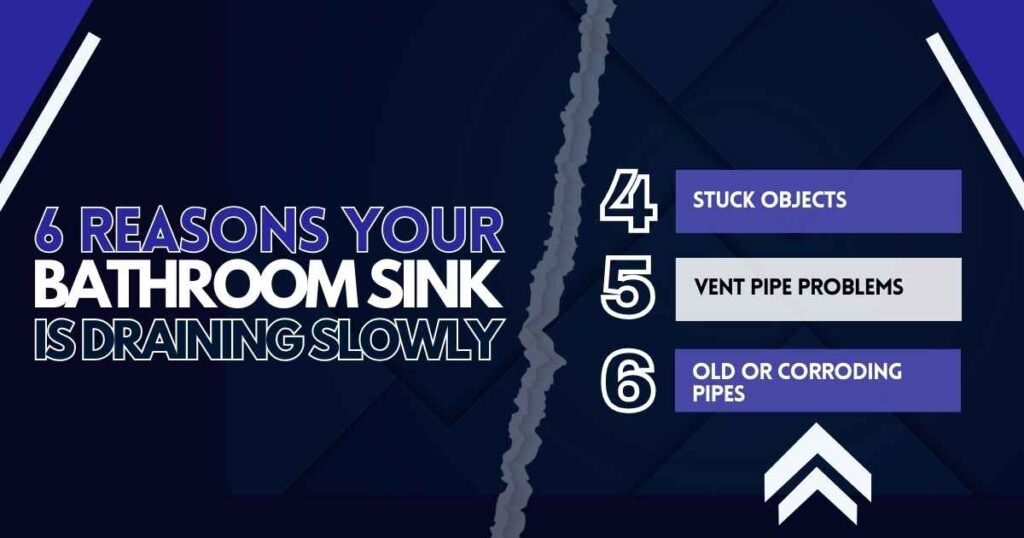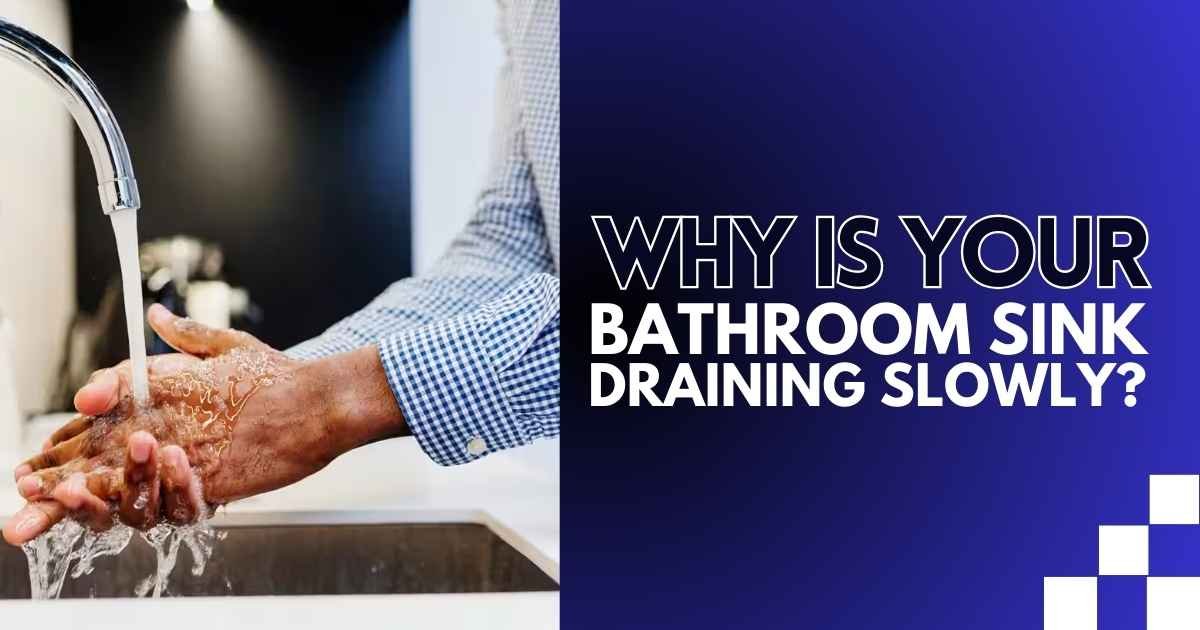You went to your bathroom sink to wash your hands, but it’s as if the drain is pretending to be a dam. The water only trickles down the drain, slowly backing up instead of disappearing. Frustrated and wondering why this keeps happening when you’re in a hurry!
It’s a problem most of us have faced, and it can be more than just an inconvenience. A slow-draining sink might seem like a minor issue, but it could signal something bigger that needs attention.
6 Reasons Your Bathroom Sink is Draining Slowly
You’ve put in the effort to turn your bathroom into a relaxing, spa-like space. But lately, you’ve noticed your bathroom sink isn’t draining as quickly as it should. Here’s how to figure out what’s behind a slow-draining sink.

1. Clogged Drain
A slow-draining sink is often caused by a clog in the pipes. Over time, things like hair, soap, toothpaste, and even food particles can build up and create blockages. In Las Vegas, where many homes have older plumbing systems, this is a common issue. Left unchecked, these clogs can lead to unpleasant odors, standing water, and even damage to your pipes.
In Las Vegas, where many homes have older plumbing systems, hot water can be particularly effective in clearing out clogs. However, using water that’s too hot, like boiling water, can damage aging pipes. For a safer option, try natural, bioenzymatic drain cleaners. They’re gentle on pipes and effective at clearing blockages.
2. Hair Buildup
Hair buildup is one of the main causes of clogs in bathroom drains and pipes, and it’s something many of us have dealt with. It doesn’t matter whose hair it is—yours, your kids’, or your partner’s—it can all pile up quickly and cause serious drainage problems when left unchecked.
To prevent hair buildup, flush drains with hot water weekly and use an enzyme or bacteria-based cleaner monthly, or more often if you have long hair. These cleaners are safe for both your pipes and family. After each shower, remove hair from the drain and use a hair cap. Be careful when grooming over the sink and clean the stopper regularly.
3. Tree Roots
Trees need a lot of water, and their roots will search for it wherever they can, even inside your pipes. This can lead to slow drainage and clogs that disrupt your plumbing. If your home is older, built before the 1980s, your pipes might be made of materials like concrete or clay, which can break down over time. Pipes can also get damaged during construction or when the ground freezes.
Sometimes, pipes may not be installed correctly, allowing tree roots to block your drains. Identifying this issue on your own can be difficult, and plumbing problems are frustrating. Since repairs may require digging up your yard, it’s best to call a professional. They can inspect your pipes, find hidden damage, and recommend repairs, saving you stress.

4. Stuck Objects
It’s easy for small things to fall down the drain when you least expect it. Maybe it’s a tiny toy your kids were playing with, a contact lens you accidentally dropped, or a bobby pin that slipped from your hand. These little objects might seem harmless, but they can easily cause clogs over time as they attract debris and build up around them.
If you’re unsure what fell in but know it happened recently, try using a shop vacuum with a sock or nylon pantyhose over the nozzle to remove the object. If that doesn’t work, don’t panic—call a plumber for help. Remember to turn off the water to prevent the object from moving further down, and stay calm. These things happen to everyone, and a quick fix can often prevent bigger issues later.
5. Vent Pipe Problems
A vent pipe, or air admittance valve, is connected to your sink’s drain pipe. It lets air into the drain to balance the air pressure when water goes down the drain. The valve lets air in when there’s negative pressure and closes when the pressure is normal.
If the vent pipe is blocked, like by debris, it can’t let air flow properly. Without air to push the water, the sink may drain slowly. You can try opening and closing the valve to see if it’s stuck. If it is, something might be blocking it. You can also check for any water leaks around the valve, which could mean it’s damaged. If air can’t get into your pipes, the valve might need to be replaced.
6. Old or Corroding Pipes
Sometimes, the problem with your drain isn’t just a clog—it’s the pipes themselves. Over time, pipes can wear down, especially in older homes. If your house has pipes that have been around for decades, like those made of copper, galvanized steel, or even plastic that’s starting to crack, they might be corroding or becoming damaged.
For example, You might notice water draining slowly in one sink, then later in the bathtub or kitchen. This could be a sign that your pipes are breaking down, restricting water flow. If the pipes are old or corroding, ignoring the issue can lead to bigger problems, like leaks or bursts.
Replacing old pipes might seem like a big task, but taking care of it now can prevent expensive repairs and further damage down the road.
DIY Solutions for a Slow-Draining Bathroom Sink

If you enjoy tackling small home projects, you might be able to fix your slow-draining sink yourself. Try these simple solutions to get things flowing again.
- Remove the Clog: To clear debris from your pipes, you can use tools like a drain snake, a zip tool, or even a wire hanger. A drain snake or zip tool is usually easier to work with, but if you don’t have one, you can straighten a wire hanger and use that instead. Just make sure to wear gloves when using the hanger, so you don’t hurt yourself, like when you’re trying to untangle a wire or reach into tight spots.
- Try a Homemade Drain Cleaner: You can use simple ingredients you likely have at home. First, pour half a gallon of boiling water down the drain if you have metal pipes (avoid this with plastic pipes). If that doesn’t help, try using baking soda. Pour half a cup of baking soda down the drain, then add half a cup of white vinegar. Wait for an hour, then flush the drain with hot water.
- Clean the P-trap: P-traps collect debris, so it’s important to clean them from time to time. First, turn off the water and place a bucket under the P-trap. Use a wrench to remove it, then dump any debris into the bucket. Finally, use a brush to clean out the pipe.
- Use a Liquid Drain Cleaner: If other DIY methods haven’t worked, you can pick up a chemical liquid drain cleaner from the store. Just follow the instructions on the label, which usually include pouring the liquid down the drain, waiting about 15 minutes, and then flushing the pipes with hot water.
Plumbing maintenance can be a simple and effective way to keep your home’s systems running smoothly, especially for homeowners who like to handle minor tasks themselves. However, without proper care, small issues can quickly become bigger and more expensive problems. Check out these “10 Plumbing Maintenance Tips for Las Vegas Homeowners” to help you avoid costly repairs and keep your plumbing in top shape.
Don’t Let a Small Problem Grow
Instead of letting a slow-draining sink stress you out and distract you from your day, it’s smarter to address the issue before it gets worse. Like many small problems, ignoring it can lead to bigger headaches in the future. Just like taking care of our health or home, fixing a simple issue now can save you from larger, more expensive problems later.
Don’t let a slow-draining sink ruin your day or turn into a bigger problem. Address it now before it gets worse. At Vegas Plumbing Pros, we’re here to help with fast, reliable service to get your drains back on track. Don’t wait until it’s too late—contact us today for a thorough inspection and affordable solutions!
FAQs
How to fix a slow draining sink?
To fix a slow-draining sink, start by removing any debris from the drain. Use a plunger to push out blockages. If the problem persists, pour a mix of baking soda and vinegar into the drain, followed by hot water after a few minutes. You can also try a drain snake to remove clogs deeper in the pipe. Cleaning the sink’s P-trap (the curved pipe under the sink) may also help.
Why is water going down the sink slowly?
A bathroom sink slow drain is usually caused by one of two things: either the drain is partially clogged, or the stopper isn’t lifting high enough to allow the water to drain properly. When the stopper doesn’t lift enough, an air bubble forms underneath, causing the water to drain slowly. To fix this, remove the stopper and check for any blockage or issues with its movement.
What is the best way to unclog a bathroom sink drain?
To clear a slow draining bathroom sink or other clogged drains, try boiling water or mixing salt with hot water and pouring it down. If that doesn’t work, use a plunger or a baking soda and vinegar mix. For stubborn clogs, a pipe snake or auger can help. As a last resort, consider using a chemical drain cleaner, but be cautious as it can damage pipes.
How to clean a bathroom sink drain?
A quick and easy way to fix a slow bathroom sink drain is by using dish soap and boiling water, says plumbing expert Allison Harrison. The dish soap helps break down grease and grime that can build up in the pipes, while the boiling water flushes it all away. This simple method leaves your drain clean and flowing smoothly without the need for harsh chemicals.



